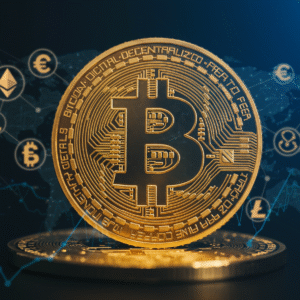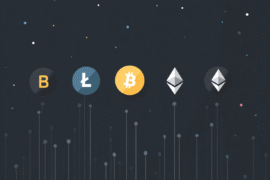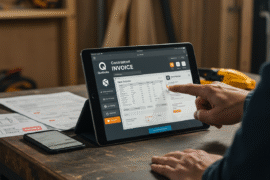This article may contain references to products or services from one or more of our advertisers or partners. We may receive compensation when you click on links to those products or services. Nonetheless, our opinions are our own.
The information presented in this article is accurate to the best of our knowledge at the time of publication. However, information is subject to change, and no guarantees are made about the continued accuracy or completeness of this content after its publication date.
- Key Highlights
- Introduction
- Understanding Bitcoin Mining Basics
- Preparing for Bitcoin Mining
- Conclusion
- Frequently Asked Questions
- Recommended Reads
Key Highlights
- Bitcoin mining involves competing to solve complex problems using specialized tools called ASIC miners.
- Miners verify transactions and secure the blockchain.
- The high energy consumption and significant startup costs make mining difficult for beginners.
- Joining mining pools enables individuals to share computational power and rewards, potentially improving profitability.
- Concerns exist about the future of mining, especially regarding regulatory compliance in regions like China and Kazakhstan.
Introduction
Cryptocurrency mining, particularly Bitcoin mining, is both a novel and complex aspect of the digital landscape. Bitcoin mining plays an essential role in securing the system by verifying transactions and appending them to the blockchain. This decentralized process allows for the introduction of new Bitcoins while maintaining transparency and trust. Although it may seem intimidating to beginners, understanding the core components and operations can simplify the process. Let’s explore the fundamentals of Bitcoin mining.
Voted "Best Overall Budgeting App" by Forbes and WSJ
Monarch Money helps you budget, track spending, set goals, and plan your financial future—all in one app.
Get 50% OFF your first year with code MONARCHVIP
Understanding Bitcoin Mining Basics
Cryptography, computational power, and decentralization form the foundation of Bitcoin mining, despite its challenging nature. This process ensures that Bitcoin transactions are validated and recorded on the blockchain. Miners use their computing power to solve complex puzzles and are rewarded for their efforts.
As more participants join the network, the difficulty of mining increases. The process requires specialized equipment and significant energy consumption, underscoring the need for careful planning and cost assessment. Let’s begin by defining Bitcoin mining and understanding its significance.
Definition and Importance
Bitcoin mining serves a critical function beyond the creation of new coins; it is fundamental to the blockchain’s operation. Bitcoin miners utilize specialized hardware, such as ASICs or GPUs, to solve complex mathematical problems and identify valid block hashes. This process demands substantial computational power and precision.
Miners are rewarded with block rewards and transaction fees for validating transactions and appending new blocks to the blockchain. Without miners, the decentralized nature of Bitcoin would be compromised. Their work ensures the accuracy and security of the ledger, safeguarding the network from manipulation.
How Bitcoin Mining Supports the Blockchain
Bitcoin mining supports the blockchain in three primary ways:
- Transaction verification: Miners solve complex puzzles to verify the authenticity of transactions. The process ensures that all data added to the blockchain is accurate and immutable, enhancing the network’s security.
- Linking blocks: Each new block in the blockchain contains a cryptographic hash of the preceding block, creating an increasingly difficult chain to alter.
- Decentralization: The widespread distribution of miners across the globe ensures that no single entity can control or manipulate the blockchain, maintaining transparency and openness.
Preparing for Bitcoin Mining
To enter the world of Bitcoin mining, you must be prepared for the associated costs, risks, and technical requirements. The investment in hardware and infrastructure is substantial, requiring thoughtful planning.
You will need to acquire ASIC miners or powerful GPUs, along with appropriate mining software. Additionally, maintaining a suitable environment with adequate cooling systems and a reliable power supply is crucial for smooth operation.
Essential Equipment and Resources Needed
Selecting the proper equipment is essential for mining success. ASIC miners are the preferred choice for solving cryptographic puzzles due to their speed and profitability compared to GPUs.
Beginners should consider joining mining pools, where multiple participants contribute their computational power to improve the chances of finding a block. Mining alone is less efficient due to high competition.
Reliable internet connectivity, low latency, and effective cooling systems are critical. Mining rigs generate considerable heat and require efficient cooling to ensure optimal performance and longevity.
Setting Up Your Mining Environment
The mining environment can significantly affect performance. Professional mining setups, such as data centers, are designed to house multiple rigs and handle the power demands of large-scale operations.
Electricity costs are a primary concern, as mining rigs consume vast amounts of power. Locating your operation in an area with affordable and stable electricity can improve profitability.
Proper ventilation and organization of equipment are key to maintaining high efficiency and reducing the risk of overheating. A clean and well-maintained environment can enhance productivity and prevent equipment failure.
Step-by-Step Guide to Beginning Bitcoin Mining
Starting a Bitcoin mining operation involves several key steps. These include selecting the appropriate hardware, installing the necessary software, joining a mining pool, and initiating the mining process. Each step requires careful consideration to maximize the return on your investment.
This guide outlines the critical aspects of setting up as a beginner, from hardware selection to potential earnings.
Step 1: Choosing the Right Hardware
Selecting the appropriate hardware is critical. ASIC miners and high-performance GPUs determine the efficiency of your mining setup. While GPUs are sufficient for smaller mining tasks, ASICs are essential for large-scale Bitcoin mining.
Investing in the latest and most efficient machines is crucial for maximizing returns. These devices are faster and more energy-efficient, increasing the likelihood of earning rewards. However, top-quality equipment can cost upwards of $10,000.
Evaluate your budget and mining goals to determine whether an ASIC or GPU setup is more suitable. Strive for a balance between cost and computational power.
Step 2: Installing Mining Software
Once your hardware is in place, install compatible mining software such as CGMiner or NiceHash. Choose software that aligns with your hardware requirements and provides strong customer support.
Mining software connects your rig to the cryptocurrency network, enabling it to perform cryptographic tasks. A properly configured system allows you to monitor performance and troubleshoot issues.
Ensure that you check installation files for malware using antivirus tools to safeguard your mining setup.
Step 3: Joining a Mining Pool
Mining on your own typically offers lower rewards due to high competition. By joining a mining pool, you combine resources with other miners, improving your chances of successfully finding a block.
Established mining pools like FoundryUSA and AntPool provide transparent payout structures and reliable infrastructure. When selecting a pool, review its fees, terms, and user feedback to ensure it meets your needs.
Joining a pool increases the likelihood of success and simplifies the mining process.
Step 4: Starting to Mine
With the proper hardware, software, and pool membership set up, you can begin mining. Your rig connects to the network and works to solve cryptographic puzzles.
Each successful hash confirms transactions and generates blocks. Mining software enables you to monitor hash rates, performance, and earnings.
Be mindful of energy and cooling costs, as they significantly impact profitability. Utilize tracking tools to optimize performance and minimize downtime.
How Bitcoin Mining Works Technically
Bitcoin mining relies on cryptography and distributed computing. It involves creating cryptographic hashes using specific algorithms and securing blocks on the blockchain.
Miners race to solve these puzzles to validate transactions, employing a process known as proof of work. Understanding hash rates and block structures helps clarify the workings of this system.
The Concept of the Hash Rate
The hash rate measures the total computational power in the Bitcoin network and is expressed in hashes per second. A higher hash rate indicates greater mining activity, which enhances security and competition.
The hash rate reflects a miner’s ability to discover blocks and the network’s resistance to attacks. Strong hash rates lead to improved performance and increased earnings.
Understanding Blocks and the Blockchain
Blocks serve as records of verified transactions. Each block contains a cryptographic hash of the previous block, ensuring immutability and maintaining the integrity of the blockchain.
Miners use computational power to solve cryptographic puzzles, adding new blocks to the Bitcoin blockchain and ensuring its decentralized nature.
The Role of Miners in Network Security
Miners play an essential role in maintaining the trustworthiness and functionality of the Bitcoin network. They verify transactions to prevent fraudulent changes and double-spending.
Each transaction is validated by multiple miners using proof of work, enhancing the transparency and decentralization of the system.
Verifying Transactions
Miners verify transaction data to ensure its accuracy and proper order. Each confirmed transaction is added to a block, linked to previous transactions through cryptographic hashes.
This verification process ensures data integrity and builds trust among participants, making it difficult for fraud to occur.
Preventing Double-Spending
Double-spending occurs when a digital coin is used more than once. The blockchain prevents such incidents by maintaining a permanent record of each transaction.
Miners use proof of work to check and secure each transaction before adding it to the blockchain.
Economic Aspects of Bitcoin Mining
The economics of Bitcoin mining are shaped by factors such as hardware costs, electricity expenses, and mining efficiency. Revenues are derived from transaction fees and block rewards, which fluctuate based on mining difficulty and Bitcoin prices.
Costs vs. Rewards Analysis
To remain profitable, miners must balance operational expenses with rewards. Energy consumption, hardware investments, and maintenance expenses must be closely monitored.
As mining difficulty increases and block rewards decrease over time, miners must adapt their strategies to stay competitive and profitable.
Factors Affecting Profitability
Profitability is influenced by the efficiency of mining hardware, local electricity prices, and market conditions. Regions with low energy costs, such as Kazakhstan and Texas, are attractive to miners due to reduced operational expenses.
Staying updated on market trends and regularly upgrading equipment can boost profitability. Monitoring costs and returns is vital for long-term success.
Legal Considerations in Bitcoin Mining
Compliance with local laws is critical for Bitcoin miners. Different regions have varying regulations regarding mining operations. For instance, China and certain U.S. states, such as New York and Texas, impose specific rules on mining activities.
Understanding local regulations helps avoid penalties and business closures. Additionally, miners must comply with tax obligations and reporting requirements to operate legally.
Jurisdictions Where Mining Is Restricted
Some regions restrict mining due to environmental concerns or energy consumption issues. China, for example, has imposed strict regulations on mining operations. Similarly, New York has halted the issuance of new mining permits.
Other countries like Kazakhstan and Canada are under scrutiny for their energy practices. Miners must stay informed about local laws to ensure their operations remain compliant.
Compliance and Regulations
Miners must adhere to local regulations, which may include obtaining permits, filing tax reports, and submitting energy consumption data. In the U.S., miners are required to comply with IRS rules and local government policies.
Adhering to these regulations ensures the legality of mining operations and promotes responsible resource use. Keeping abreast of regulatory changes is essential for sustainable operations.
Environmental Impact of Bitcoin Mining
Bitcoin mining consumes significant energy, much of which is sourced from fossil fuels, raising concerns about its environmental impact. Data centers used in mining operations generate considerable heat and require efficient cooling systems.
Energy Consumption Concerns
The energy-intensive nature of Bitcoin mining places substantial stress on the environment. Fossil fuel-based energy sources contribute to the carbon footprint of large-scale mining operations.
Utilizing renewable energy sources and adopting efficient cooling systems are essential steps toward reducing the environmental impact of mining.
Sustainable Mining Practices
The industry is shifting toward more sustainable practices, including the use of renewable energy such as solar, wind, and hydroelectric power. This transition helps reduce reliance on fossil fuels and lowers carbon emissions.
Upgrading hardware and optimizing cooling systems further reduces energy consumption, lowering costs and improving the environmental perception of the cryptocurrency industry.
Future of Bitcoin Mining
Technological advancements continue to shape the future of Bitcoin mining. More efficient ASIC miners, improved algorithms, and innovations like cloud mining are making the process more accessible and sustainable.
Technological Advancements
Modern ASIC miners are faster and more energy-efficient, allowing processors to process more transactions while consuming less power. These advancements help improve the scalability and security of the Bitcoin network.
Cloud mining platforms enable more people to participate in mining without the need for expensive hardware, broadening access to the digital economy.
Trends in Decentralization
Decentralization is a key trend in Bitcoin mining. Mining pools and decentralized finance (DeFi) platforms are promoting collaboration and opportunity within the mining ecosystem.
Regions with favorable conditions, such as Texas and Canada, are attracting miners seeking lower operational expenses, contributing to a more decentralized and secure network.
Conclusion
Bitcoin mining requires strategic planning, technical expertise, and knowledge of local regulations. Miners must be aware of the financial, legal, and environmental challenges involved. As the industry evolves, miners play a crucial role in maintaining the security and transparency of the blockchain.
The future of mining will be shaped by technological innovations, sustainability efforts, and regulatory clarity. By staying informed and adaptable, miners can thrive in this dynamic field.
Frequently Asked Questions
What is the minimum amount of money needed to start mining?
The initial cost depends on your hardware, electricity, and the scale of your setup. You might spend a few hundred dollars to several thousand. It’s important to plan your budget with long-term profitability in mind.
Could you please let me know how long it typically takes to mine one Bitcoin?
The time to mine Bitcoin depends on factors like mining difficulty and hash rate. Typically, a block is mined every 10 minutes, but the actual time varies based on computational power and network participation.
Can Bitcoin mining be a full-time job?
Yes, Bitcoin mining can be a full-time job, especially if you own multiple mining rigs or work with a mining pool. However, you need to evaluate whether the costs outweigh the rewards, especially considering fluctuating Bitcoin prices and operational expenses.

Reviewed and edited by Albert Fang.
See a typo or want to suggest an edit/revision to the content? Use the contact us form to provide feedback.
At FangWallet, we value editorial integrity and open collaboration in curating quality content for readers to enjoy. Much appreciated for the assist.
Did you like our article and find it insightful? We encourage sharing the article link with family and friends to benefit as well - better yet, sharing on social media. Thank you for the support! 🍉
Article Title: Bitcoin Mining Operation: How It Works for Beginners
https://fangwallet.com/2025/05/13/bitcoin-mining-operation-how-it-works-for-beginners/The FangWallet Promise
FangWallet is an editorially independent resource - founded on breaking down challenging financial concepts for anyone to understand since 2014. While we adhere to editorial integrity, note that this post may contain references to products from our partners.
The FangWallet promise is always to have your best interest in mind and be transparent and honest about the financial picture.
Become an Insider

Subscribe to get a free daily budget planner printable to help get your money on track!
Make passive money the right way. No spam.
Editorial Disclaimer: The editorial content on this page is not provided by any of the companies mentioned. The opinions expressed here are the author's alone.
The content of this website is for informational purposes only and does not represent investment advice, or an offer or solicitation to buy or sell any security, investment, or product. Investors are encouraged to do their own due diligence, and, if necessary, consult professional advising before making any investment decisions. Investing involves a high degree of risk, and financial losses may occur including the potential loss of principal.
Source Citation References:
+ Inspo
There are no additional citations or references to note for this article at this time.












































